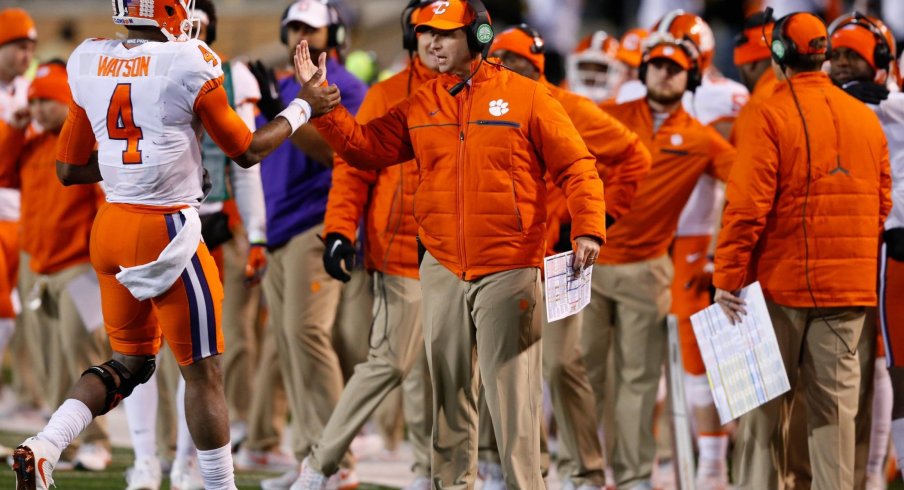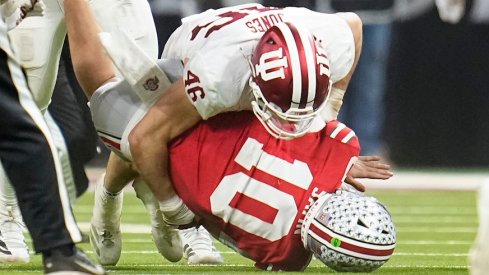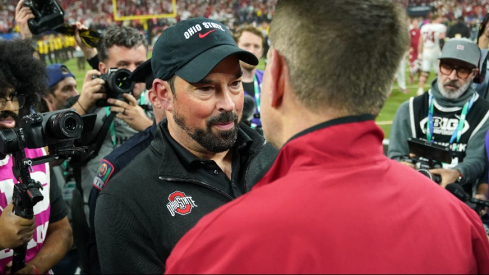Whether they knew it or not, this Buckeye defense has been preparing to face Clemson since March.
While Spring practice time is rarely ever focused on defeating the schemes of a specific opponent, much of what Raekwon McMillan, Malik Hooker, and company will see in the upcoming Fiesta Bowl will look eerily like what they faced in those extra practice sessions. Clemson coach Dabo Swinney moved his program up from ACC also-ran to national contender five years ago when he adopted a 'spread-to-run' philosophy, which was most associated with none other than Urban Meyer at the time.
Though Swinney was a wide receiver at the University of Alabama and coached the position during his time as an assistant, he has long been known more for his leadership and recruiting ability than as a scheme guru. Rather, his hiring of former Texas high school coaching legend Chad Morris in 2011 brought the Tigers into the 21st century.
Morris learned the uptempo, no-huddle philosophy made famous by Gus Malzahn directly from the source while the two were re-writing prep record books in the early part of the last decade. At the same time, Meyer was busy winning games at Bowling Green, Utah, and Florida with a power running game from the shotgun.
| Year | YPG | FBS Rank |
|---|---|---|
| 2008 | 329.4 | 87th |
| 2009 | 362.4 | 74th |
| 2010 | 334.5 | 88th |
| 2011 | 440.8 | 26th |
| 2012 | 512.7 | 9th |
| 2013 | 508.5 | 9th |
| 2014 | 408.3 | 61st |
| 2015 | 514.5 | 11th |
| 2016 | 505.7 | 13th |
The effect these three have had on the game is immeasurable, as today, 'spread' concepts have moved far beyond the novelty stage and are now the norm for high school and college offenses across the country. However, multiple varieties of the spread have emerged, such as the 'Air Raid,' placing the emphasis on different parts of the offense.
For Morris and Meyer, their versions have always been primarily run from '11' personnel (1 running back and 1 tight end), with the tight end often lining up behind the line of scrimmage in an 'off' position and acting like a fullback. Both running games feature classic downhill concepts like the Tight (inside) Zone, Power-O, Power-Read, and Counter Trey, with passing attacks based on the philosophy of one-back offense pioneer Dennis Erickson.
The key position for both offenses, though, is clearly the one under center.
“The differences are obviously that athlete [quarterback Deshaun Watson]" said Meyer this past week when asked about defending the Tigers. "Rarely you find a guy that's that big and fast and can throw. We'll have those conversations this weekend, how we'll play Deshaun and those three receivers as well.”
In both systems, the QB must be able to run, throw, and most importantly, make quick decisions. The Tigers feature a number of 'read' concepts, not only on the ground, but with run-pass options that ask Watson to determine whether to handoff, run, or throw based upon the movement of the defense, all of which should sound familiar to Buckeye fans.
“They’re a tempo team with a lot of shifts and motions," Swinney said about Ohio State's offense and quarterback J.T. Barrett during his press conference this week. "They’re going to run their quarterback, but he's surrounded by a great cast. Two really good football teams and we’ve got a lot of respect for Ohio State."
But the parallels don't end there for the two units. After leading Ohio State to its two most productive seasons in school history, offensive coordinator Tom Herman left to take over the University of Houston program at the same time Morris did the same just up the road at SMU. With huge shoes to fill in Clemson and Columbus, Swinney and Meyer both opted to name two coaches to the coordinator role.
While Ed Warinner and Tim Beck have taken their fair share of criticism, despite leading Ohio State's fifth-best offense in terms of total yardage this fall, Tiger co-coordinators Tony Elliott and Jeff Scott have seen a bit of friendly fire come their way as well. Despite some confusion within the Clemson fanbase about who fills what role, Elliott is the lead play-caller with direct input from Scott as the duo continues to execute the philosophies instilled by Morris.
Though the arrangement may be a bit unorthodox, the results speak for themselves. As seen in this three-play touchdown drive in the second quarter of their big win over Louisville, the Tigers do an excellent job of pushing the tempo to go 56 yards in just over 65 seconds of real time.
"We wanted to be aggressive," Elliott said after the game. "Aggressive worked for us early in the game, but we're at our best when we can dictate the pace of the game, be aggressive, throw the ball when we want to, run the ball when we want to."
Many teams attempt to push the pace, but the Tigers' ability to run multiple concepts from nearly identical alignments makes their fast-paced attack far more effective. Elliott and Scott have a clear plan on this possession, noticing the way the safeties cheat on the first play to set up the big touchdown throw against single coverage:
Jet-Motion Play 1: Inside Zone
Jet-Motion Play 2: Jet Sweep
Jet-Motion Play 3: Y-Cross
Though Elliott is in charge of building the weekly running game plan while Scott handles the aerial attack, the pair does an excellent job building off one another, constraining the defenders who cheat up to stop one play by attacking them directly the next (in this case, the safeties).
But while the Tiger offense closely resembles that of the Buckeyes on paper, the pieces they've plugged into it are a bit different. As you might expect from a former wide receiver, Swinney has turned Clemson into a destination for young wideouts from all over the southeast, each of whom looks to become the next Deandre Hopkins of Sammy Watkins.
While Buckeye game plans focus on getting the ball to the running back and 'H' (slot) receivers, outside receivers have flourished in the offense Morris designed for Swinney. Since Morris arrived in 2011, the Tigers have seen an outside receiver record 900 receiving yards or more in a season eight times.
The only issue with such a focus is it's harder to get the ball to players on the outside as it is to hand it off. While Watson and his receivers have been explosive this year, totaling 37 touchdowns through the air, the biggest knock on the potential top pick in this April's draft has been a tendency to get sloppy and turn the ball over.
Specifically, the Tigers have struggled to put good opponents like Louisville, Florida State, Virginia Tech, and Pittsburgh away despite building big leads, thanks in large part to interceptions. The third quarter, especially, has been an issue, as Watson threw six interceptions to five touchdowns, despite his team almost always holding the lead.
What the Clemson offense will show the Buckeyes won't be new, as nearly every formation, motion, and concept can also be found in Meyer's playbook as well. Much as they were in their last game, the Ohio State linebackers and safeties specifically must remain disciplined in their approach, not allowing Watson and his play-making wideouts to gash them for big plays.
For the Buckeyes to reach the CFP championship, the key to stopping Swinney, Watson, and the Tigers won't be understanding WHAT plays they'll call, but rather WHEN they'll call them.



